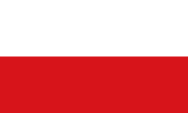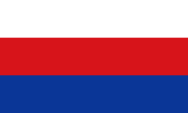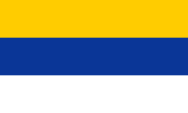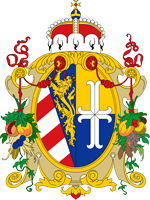Görz und Gradisca |
|
|
|
| Übersicht – Contents: | |
Görz und Gradisca |
|
|
|
| Übersicht – Contents: | |
Flaggen – Flags: |
|
 |
1861–1919, Landesflagge (Landesfarben) – Flag of the country (colours), Seitenverhältnis – ratio = 2:3, Quelle/Source nach/by: Flags of the World |
 |
Görz/Gorizia Landesflagge (Landesfarben) – Flag of the country (colours), Seitenverhältnis – ratio = 2:3, Quelle/Source nach/by: Flags of the World |
 |
Gradisch/Gradisca Landesflagge (Landesfarben) – Flag of the country (colours), Seitenverhältnis – ratio = 2:3, Quelle/Source nach/by: Flags of the World |
|
|
|
Bedeutung/Ursprung der Flagge – Meaning/Origin of the Flag: |
|
| Das Land hatte, wie alle Kronländer der österreichischen Krone, seine eigenen, sogenannten Landesfarben, die unter anderem auf horizontal getreiften zwei- oder dreistreifigen Flaggen gezeigt wurden. Die Landesfarben waren sehr oft dem jeweiligen Wappen des Kronlandes entnommen oder wurden duch eine weitere, nicht im Wappen enthaltene Farbe ergänzt, oder sie gingen auf ältere Modelle des Landeswappens zurück (z.B. Krain). Offiziell waren die Landesfarben aber nie geregelt oder festgelegt worden, so dass deren Reihenfolge in der Praxis of variierte oder die Farben gar an sich abwichen. |
The country had – like all the other crown lands of the Austrian
crown – its own colours (Landesfarben), which were used amongst others on
horizontally two- or three-striped flags. The colours (Landesfarben) were very often taken from the respective coat of arms of the country or were supplemented by another colour, which not appears in the coat of arms, or they went back to older models of the coat of arms (e.g. Carniola). Officially, the colours had never been regulated or stipulated, so that their sequence varied in practice or even the colors deviated. |
| Der österreichische Heraldiker Hugo Gerard Ströhl (1851–1919) hat sich wohl als erster des Themas angenommen und wahrscheinlich um das Jahr 1890 herum die Landesfarben auf den Flaggen bei den jeweiligen Landesbehörden abgefragt und zusammengestellt. | The Austrian heraldist Hugo Gerard Ströhl (1851–1919) was probably the first to take care of it and asked for the colors (Landesfarben) on the flags at the respective state authorities around 1890 and compiled them. |
| Das Kronland "Gefürstete Grafschaft Görz und Gradisca", welches 1861 geschaffen wurde, verwendete als Landesfarben eine Flagge die zwei horizontale Streifen in Weiß und Rot zeigte. Die Farben stammen vom Wappen Görz, welches unter anderem sechs Streifen in Weiß und Rot zeigte. | The Crown
Land "Princely County of Goerz und Gradisca", formed in 1861, used as
colours of the country a flag which showed two horizontal stripes in white
and red. The colours descend from the coat of arms of Goerz which showed among other six stripes in white and red. |
| Die Farben Weiß und Rot könnten aber auch eine Kompromisslösung sein, denn: |
The colors white and red could also be a compromise solution, because: |
| Von der
alten Grafschaft Görz war Gradisca zwischen 1500 und 1516 abgetrennt, und
dann noch mal zwischen 1647 und 1717. Zumindest im letzeren Fall war das mit
einem eigenen Wappen verbunden, dass sich ähnlich bis in die heutige Zeit
erhalten hat. In der Zeit der Habsburger Monarchie zeigte das Wappen ein in Gold und Blau geteiltes Schild und in der Mitte ein geschliffenes silbernes Ankerkreuz, also die Farben Gold, Blau und Silber. Diese Farben werden von einigen Quellen als Landesfarben von Gradisca genannt, jedoch nirgends verifiziert. |
Gradisca was separated from the old County of Gorizia between 1500 and 1516, and then again between 1647 and 1717. At least in the latter case it was combined with an own coat of arms, which has been similarly preserved up to the present days. During the time of the Habsburg monarchy, the coat of arms showed a between gold and blue parted per fess (halved horizontally) shield and in the middle a silvery anchor cross, what finally means the colours: gold, blue and silver. Some sources refer to these colours as the colours of Gradisca (Landesfarben), but they are not verified anywhere. |
|
In der Zeit der
Habsburger Monarchie war das Wappen der Grafschaft Görz diagonal von links
oben nach rechts unten geteilt, und zeigte oberhalb der Diagonale einen
gekrönten goldenen Löwen auf Blau, und unterhalb sechs Streifen in Silber
und Rot, also die Farben Silber, Rot und Blau. Diese Farben werden von einigen Quellen als Landesfarben von Görz genannt, jedoch nirgends verifiziert. |
During the time of the Habsburg monarchy, the coat of arms of the County of Gorizia (Goerz) was parted per bend (diagonally from upper left to lower right), and showed a crowned golden lion on blue above the diagonal and six stripes in silver and red, what finally means the colours: silver, red and blue. Some sources refer to these colours as colours of Gorizia (Landesfarben), but they are not verified anywhere. |
| Die Farben von Görz und Gradisca sind dabei wohl weniger das Problem, eher der Umstand das beide Landesteile wahrscheinlich beide eigene Farben hatten. Hier gibt es sehr viele mögliche Farbkombinationen, alle auf die Farben der Wappen bezogen, die als Landesfarben für Landesteile angegeben werden. |
The colours of Gorizia and Gradisca are not so
much the problem, but rather the fact that both parts of the country
probably both had their own colours. There are many possible color combinations here, all related to the colors of the coat of arms, which are all seem given as the colors for the parts of the country. |
| Angeommen es stimmt wirklich, dass Görz und auch Gradisca eigene Landesfarben gehabt hätten (eigentlich ein Prozess der in deutschen Binnenländern erst um 1830 abgeschlossen war), könnten die Farben Weiß und Rot für "Gefürstete Grafschaft Görz und Gradisca" einem Kompromiss darstellen, denn je eine der beiden Farben kommt im jeweiligen Wappen, oder auch in den Landesfarben, vor. Angeblich durften die die Landesfarben der Landesteile in beiden Landesteilen bis 1918 ganz legal zusätzlich zu Weiß und Rot verwendet werden. | Assuming that it is true that Gorizia and Gradisca had their own colours (actually a process that was completed in the German interior lands not until 1830), the colours white and red could be a compromise for the "Princely County of Gorizia and Gradisca", because each one of the two colours appears in the respective coat of arms, or also in the colours (Landesfarben). Supposedly, the above mentioned colors could have been used legally in the both parts of the country in addition to white and red until 1918. |
| Quelle/Source: Österreichisch-Ungarische Wappenrolle, Flags of the World, Volker Preuß | |
Wappen – Coat of Arms: |
|
 |
Wappenschild von Görz und Gradisca – blazon of Gorizia und Gradisca, Quelle/Source nach/by: Flags of the World |
 |
ca.1890–1918, Wappen von Görz und Gradisca – Coat of arms of Gorizia und Gradisca, Quelle/Source, nach/by: Ströhl, Wappenrolle Österreich-Ungarns, 1890, via Wikipedia (D) |
 |
Wappenschild der Grafschaft Görz – blazon of the County of Gorizia, Quelle/Source, nach/by: Wikipedia (D) |
 |
Wappenschild von Gradisca – blazon of Gradisca, Quelle/Source, nach/by: Österreichisch-Ungarische Wappenrolle |
Bedeutung/Ursprung des Wappens – Meaning/Origin of the Coat of Arms: |
|
| Das Wappen
der "Gefürsteten Grafschaft Görz und Gradisca" zeigt einen gespaltenen Schild,
vorn das Wappen von Görz, vorne geschrägt, oben in Blau ein golden gekrönter
ebensolcher Löwe, unten fünfmal von Silber und Rot gegengeschrägt, hinten das
Wappen von Gradisca, ein silbernes Ankerkreuz in einem Gold über Blau geteilten
Feld. Der Schild trägt einen Fürstenhut. Das Wappen von Görz geht auf das Haus der Meinhardiner zurück. Sie werden auch "Görzer" genannt. |
The coat of arms of the "Princely County of Gorizia and Gradisca" shows a parted per pale shield, the coat of arms of Gorizia in front, in front parted per bend, a golden crowned golden lion in blue above, below five times in silver and red parted per bend sinister, in the back the coat of arms of Gradisca, a silvery anchor cross in a gold over blue parted per fess field. The shield wears a princely hat. The coat of arms of Gorizia goes back to the house of the Meinhardiner. They are also called "Görzer" (House of Gorizia). |
| Der österreichische Heraldiker Hugo Gerard Ströhl hat das Wappen um 1890, in seiner letzten bekannten Ausführung, mit landestypischen Früchten umgeben, welche die Bedeutung des Landes als Landwirtschafts- Obstbauregion hervorheben sollten. Man erkennt Mais, Granatäpfel, Wein und Kirschen. | The Austrian heraldist Hugo Gerard Ströhl surrounded the coat of arms ca. 1890, in its last known version, with for the country typical fruits, to emphasize the importance of the country as a agricultural and fruit-growing region. You can see corn, pomegranates, wine and cherries. |
| Quelle/Source: Österreichisch-Ungarische Wappenrolle, Wikipedia (D), Volker Preuß | |
|
Landkarte der Kronländer des Küstenlandes – Map of the crown lands of the Austrian-Illiric Littoral: |
|
| Landkarte/Map: Volker Preuß |
| die Kronländer Österreich-Ungarns – Crown Lands of Austria-Hungary: |
|
| Quelle/Source: Volker Preuß |
Zahlen und Fakten – Numbers and Facts: |
|
|
|
|
|
|
|
|
|
|
|
|
|
|
|
|
Geschichte: |
| ca. 80
v.Chr. · die Eroberung der Region durch das
Römische Reich ist
abgeschlossen, zur Provinz Italia 395 · bei der Teilung des Römischen Reiches kommt die Region an das Weströmische Reich 476–489 · die Region gehört zum Reich des Odoaker 489–553 · die Region gehört zum Reich der Ostgoten 6. Jhd. · Besiedlung durch Slawische Stämme ca. 800 · die Region wird durch das Frankenreich der Karolinger unterworfen, und kommt zur neu gegründeten "Markgrafschaft Friaul" 9. Jhd. · die Markgrafschaft Friaul kommt zur neu gegründeten Markgrafschaft Verona 952 · die Markgrafschaft Verona kommt zu Bayern 976 · die Markgrafschaft Verona kommt zum Herzogtum Kärnten 10./11. Jhd. · die Region kommt unter den Einfluss der Patriarchen von Aquileia 12. Jhd. · die Grafschaft Görz macht sich unter den Grafen von Görz vom Patriarchat von Aquileia unabhängig 1286 · das Haus Görz erwirbt das Herzogtum Krain 1335 · Aussterben des Hauses Görz (jüngere Linie) in Kärnten 1363 · Aussterben des Hauses Görz (jüngere Linie) in Tirol 1500 · Aussterben auch der älteren Linie des Hauses Görz, die Grafschaft Görz kommt als Erbschaft an das Haus Habsburg, es kommt zu Streitigkeiten mit Venedig, das Gradisca für sich beansprucht 1516 · Frieden von Brüssel, Venedig tritt Gradisca an das Haus Habsburg ab 1647 · Kaiser Ferdinand III. trennt Gradisca von der Grafschaft Görz ab und gibt sie gegen Entgelt als Gefürstete Grafschaft Gradisca (Deutsch: Gradis oder Gradisch) dem Haus Eggenberg zum Lehen 1717 · die Eggenberger sterben aus, das Lehen erlischt und wird eingezogen, Görz und Gradisca werden zur Gefürsteten Grafschaft Görz und Gradisca vereint 1797–1809 · Französische Revolutionskriege: ein Teil Österreichs (Steiermark) wird 1797 von den Franzosen besetzt 1809 · Friede von Wien, Österreich verliert Salzburg, das Innviertel, Westgalizien und Teile von Ostgalizien und tritt Istrien, Triest, Görz, Krain, Kärnten, Kroatien, und Dalmatien an Frankreich ab, die 1810 zu den französischen "Illyrischen Provinzen" zusammengefasst werden 1813 · Österreich erklärt Frankreich (Napoléon) den Krieg 1814/1815 · Wiener Kongress, Neuordnung Europas nach der Ära Napoléon, das Kaiserreich Österreich (Haus Habsburg) erhält die 1809 verlorenen Gebiete zurück; Istrien, Triest, Görz, Kärnten und Krain werden zum Habsburgischen Königreich Illyrien zusammengefasst, Dalmatien und Kroatien werden wieder an Ungarn (unter den Habsburgern, Teil des Kaiserreichs Österreich) angeschlossen 1848/1849 · Revolution in Wien, Bürgerkrieg zwischen Ungarn und Kroaten, Aufstände in Prag, Mailand und Venedig, daraufhin dankt Kaiser Ferdinand I. ab und Franz Joseph I. von Habsburg wird neuer Kaiser, die Aufstände werden niedergeschlagen und er erlässt eine neue Verfassung: die Titular-Erblande der Habsburger im Kaiserreich Österreich werden zu Kronländern mit eigenen Landtagen umgewandelt, der dalmatische Landtag lehnt den Anschluss an Kroatien ab, das Königreich Dalmatien wird ein eigenes Kronland der österreichischen Krone, Kroatien und Slawonien werden zum "Königreich Kroatien und Slawonien" vereinigt, das als Nebenland bei der ungarischen Krone verbleibt, Auflösung des Königreichs Illyrien: Aufteilung in die Kronländer Krain, Kärnten, Küstenland, Kroatien und Slawonien und Dalmatien 1861 · neue österreichische Verfassung, die drei Bestandteile des Küstenlandes, Markgrafschaft Istrien, Gefürstete Grafschaft Görz und Gradisca, Reichsunmittelbare Stadt Triest mit ihrem Gebiet werden eigene Kronländer mit eigenen Parlamenten, allerdings unter einem gemeinsamen Statthalter, dem Landeschef des Österreichisch-Illirischen Küstenlands mit Sitz in Triest 1914–1918 · Erster Weltkrieg, danach Zusammenbruch der Kaiserlich-Königlichen Monarchie, Zerfall von Österreich-Ungarn in Nationalstaaten 10.09.1919 · Friedensvertrag von Saint-Germain nach dem Ersten Weltkrieg, Österreich muss Görz und Gradisca an Italien abgetreten, als "Provincia di Gorìzia" Italien angeschlossen 1945 · Eroberung und Besetzung der Region durch jugoslawische Partisanen gegen Ende des zweiten Weltkriegs, Vertreibung und teilweise auch Ermordung des größten Teils der im Lande verbliebenen deutschen Zivilbevölkerung 1947 · in Folge des 2. Weltkrieges muss Italien ca. 85% des Territoriums der "Provincia di Gorìzia" an Jugoslawien (heute Slowenien) abtreten, Teilung der Stadt Görz |
History: |
|
ca. 80
B.C. · the conquest of the region by the
Roman Empire is finished, to the
province of Italia 395 · at the partition of the Roman Empire the region comes to the West Roman Empire (Rome) 476–489 · the region belongs to the Empire of the Odoaker 489–553 · the region belongs to the Empire of the Eastern Goth 6th cent. · settlement by Slavic tribes 569–598 · conquest by the Pannonian Avars ca. 800 · the region becomes subjected by the Frankish Empire of the Carolingians, the region comes to the Margraviate of Friaul 9th cent. · the Margraviate of Friaul comes to the new established Margraviate of Verona 952 · the Margraviate of Verona comes to Bavaria 976 · the Margraviate of Verona comes to the Duchy of Carinthia 10th/11th cent. · the region comes in influence of the Patriarchs of Aquileia 12th cent. · the County of Gorizia (Goerz) becomes independent from the Patriarchate of Aquileia under the Counts of Gorizia (Goerz) 1286 · the House of Gorizia earns the Duchy of Carniola 1335 · Vanish of the House of Gorizia (younger lineage) in Carinthia 1363 · Vanish of the House of Gorizia (younger lineage) in Tyrolia 1500 · Vanish of the older lineage of the House of Gorizia, the County of Gorizia comes as inheritance to the House of Habsburg, there are disputes with Venice, which claims Gradisca 1516 · Peace of Brussels, Venice cedes Gradisca to the House of Habsburg 1647 · Emperor Ferdinand III. separates Gradisca from the County of Gorizia and gives it as a fiefdom to the house of Eggenberg as Princely County of Gradisca (German: Gradis or Gradisch) 1717 · the Eggenbergers die out, the fief goes out and is retracted, Gorizia and Gradisca are united to the Princely County of Gorizia and Gradisca 1797–1809 · French Revolutionar Wars, parts of Austria (Styria) become occupied by the French in 1797 1809 · Peace of Vienna, Austria loses Salzburg, the Inn Quarter, Western Galicia and parts of Eastern Galicia and cedes Istria, Trieste, Gorizia, Carniola, Carinthia, Croatia, and Dalmatia to France, which were merged in 1810 to the French "Illyrian Provinces" 1813 · Austria declares war on France (Napoléon) 1814/1815 · Congress of Vienna, realignment of Europe after the era Napoléon, the Empire of Austria (House of Habsburg) acquires back the in 1809 lost territories; Istria, Trieste, Gorizia, Carinthia and Carniola become merged to the Habsburg's Kingdom of Illyria, Dalmatia and Croatia become re-annexed to Hungary (under the Habsburgs, part of the Empire of Austria) 1848/1849 · revolution in Vienna, civil war between Hungarians and Croats, riotings in Prague, Mailand and Venice, as a result of that Emperor Ferdinand I. resigns and Franz Joseph I. of Habsburg becomes new Emperor, the riotings become suppressed and he enacts a new constitution: the titular hereditary territories of the Habsburgs in the Austrian Empire become converted to crown lands with their own Landtag (parliament), the Landtag of Dalmatia rejects the annexion to Croatia, the Kingdom of Dalmatia becomes an own crown land of the Austrian crown, Croatia and Slavonia become united to the "Kingdom of Croatia and Slavonia", which remains as a subsidiary country under the Hungarian crown, dissolution of the Kingdom of Illyria: division in the crown lands of Carniola, Carinthia, Littoral, Croatia and Slavonia and Dalmatia 1861 · new Austrian constitution, the three components of the Littoral, Margraviate of Istria, Princely County of Gorizia and Gradisca and the Imperial Free City of Trieste and its surrounding area, become own crown lands with their own parliaments, but under a common head of state, the governor of the Austrian-Illiric Littoral with his seat in Trieste 1914–1918 · First World War, thereafter breakdown of the imperial-royal monarchy, disintegration of Austria-Hungary in national states 10th of September 1919 · Treaty of Peace of Saint-Germain after the First World War, Austria has to cede Gorizia and Gradisca to Italy, affiliated to Italy as "Provincia di Gorìzia" 1945 · conquest and occupation of the area by Yugoslav partisans at the end of the Second World War, expulsion and partially even assassination of the largest part of the in the country remained German civilian population 1947 · as a result of the 2nd World War Italy has to cede ca. 85% of the territorry of the "Provincia di Gorìzia" to Yugoslavia (nowadays Slovenia), partition of the City of Gorizia |
| Quelle/Source: Atlas zur Geschichte, Wikipedia (D), RetroBib Retrobibliothek, Discovery '97, Volker Preuß |
| geschichtliche Landkarten – historical Maps: | |
|
|
|
|
|
|
| Landkarte/Map: Volker Preuß | |
Ursprung des Landesnamens – Origin of the Country's Name: |
|
|
Der Name der Stadt Görz, der Sitz der Grafen von Görz aus dem Hause der
Meinhardiner, geht auf das slawische Wort "gorica" zurück, was "kleiner
Hügel" bedeutet. Görz wird italienisch "Gorizia" genannt, slowenisch "Gorica" furlanisch "Gurize" und auf Englisch "Gorz, Goerz oder Gorizia". |
The name of the town of Gorizia, the seat of the Counts of Gorizia from the House of the Meinhardiner, comes from the Slavic word "gorica", what means "little hill". Gorizia is called "Gorizia" in Italian, in Slovenian "Gorica" in Furlanic "Gurize" and in English also "Gorz or Goerz". |
| Der Name der Stadt Gradisca, geht auf das slawische Wort "gradec" zurück, was "kleine Burg" bedeutet. Der italienische Name der Stadt, "Gradisca", lautet auf Deutsch "Gradis / Gradisch", genannt auf Slowenisch "Gradišče", auf Furlanisch "Gardiscja / Gardiscje" und auf Englisch ebenfalls "Gradisca". | The name of the town of
Gradisca comes from the Slavic word "gradec", which means "little castle". The Italian name of the town, "Gradisca", is "Gradis or Gradisch" in German, "Gradišče" in Slovenian, "Gardiscja or Gardiscje" in Furlan and "Gradisca" in English. |
| Was ist eine Gefürstete Grafschaft? Eine Grafschaft wird von einem Grafen regiert. Ein Graf untersteht normalerweise einem höheren Adeligen, z.B. einem Herzog - die Grafschaft ist somit Teil eines Herzogtums. Ein Herzog gehört, im Gegensatz zum Grafen, als Reichsfürst zum Hochadel, untersteht dem Kaiser direkt und hat Zutritt zum den Kaiser beratenden Reichsfürstenrat. Der Kaiser konnte jedoch einen Grafen in den Stand eines Reichsfürsten erheben, ohne das er einen neuen, höheren Titel bekam. Er hatte Zutritt zum Reichsfürstenrat und wurde "gefürsteter Graf" oder "Reichsgraf" genannt. | What is a Princely
County? A county is ruled by a count. A count is usually subordinated to a
higher noble, e.g. a duke - the county is therefore part of a duchy. In contrast to the count, a duke belongs to the nobility as imperial prince, is directly subordinated to the emperor and has access to the imperial prince's council, which advises the emperor. However, the emperor was able to elevate a count to the rank of an imperial prince, without that he received a new and higher title. He had access to the imperial prince's council and was called "princely count" or "imperial count". |
| Quelle/Source: Handbuch der geographischen Namen, Wikipedia (D), Volker Preuß | |
| • Reich der Österr. Habsburger (bis 1804) • Kaiserreich Österreich (1804–1867) • Österreich-Ungarn (1867–1918) • Republik Österreich (seit 1918) |
• Empire of the Austrian Habsburgs (to 1804) • Empire of Austria (1814–1867) • Austria-Hungary (1867–1918) • Republic of Austria (since 1918) |